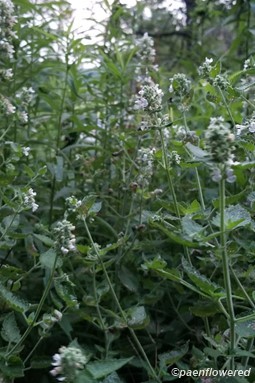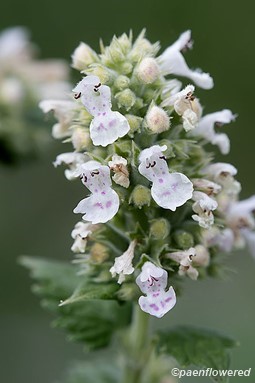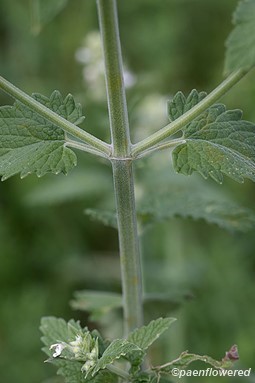Nepeta cataria
A fragrant mint attractive to cats
Nepeta cataria catnip
This perennial and herbaceous member of the mint family is probably native to Europe, the Middle East and parts of Asia but was introduced to North America from Europe. The leaves of this mint are triangular or ovate in shape, toothed and covered with grayish down. The pattern of veins is quite visible.
The fragrant flowers of catnip bloom from June to September. Small individual flowers grow on a crowded terminal flower head. The flowers may be in a continuous group or interrupted by bare spaces on the stalk. The individual flowers are ½ inch-long, have 2 lips and are white with pinkish-purple spots on the lower lip. The corolla is tubular with 2 pairs of stamens in the opening of the throat.
The leaves are pointed, and have toothed margins and long stalks. Like most alien plants, catnip grows in waste places, roadsides, and pastures. It can grow one to three feet high and, like most mints, has a square stem. It is locally abundant throughout North American, but is more abundant in the northern states or in the eastern mountains. It is found in every county in Pennsylvania.
The leaves contain a chemical called nepetalactone that is attractive to most but not all cats. (33% do not react.) The tendency for a cat to react is hereditary. Several species of large wild cats react to Catnip in a similar manner to domestic cats. When sensitive cats encounter the crushed leaves they roll on the ground, paw at the catnip and lick and chew it. The effect wears off after several minutes. About two hours later the cat is prone to the same reaction. If a cat eats too much catnip they can become anxious or aggressive.
The chemical in catnip is also an effective mosquito repellant, though it does not work well if applied to the skin. Catnip can also be planted as a garden ornamental, attracting butterflies but repelling aphids and squash bugs. It is deer resistant. Native Americans and early European settlers used to make medicinal tea from the leaves. In some places it is also called field balm, catmint or catsworth.
Habitat & Range
Grows in meadows, fields, forests and any man-disturbed habitats.
Present throughout the state.
| EMP: | FACU |
|---|---|
| NCNE: | FACU |
Phenology
Flowers June through September.








Comments
Have you spotted this plant in your area? We'd love to hear about your experience! Share your comments or questions about the plant below. Comments are moderated before posting.